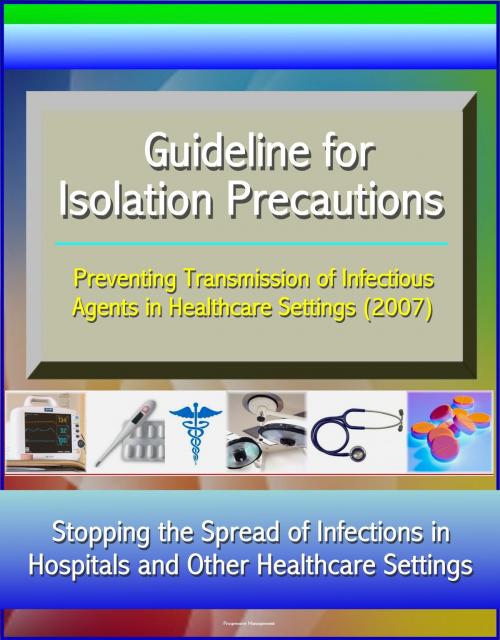Guideline for Isolation Precautions: Preventing Transmission of Infectious Agents in Healthcare Settings (2007) - Stopping the Spread of Infections
Nonfiction, Health & Well Being, Health, Ailments & Diseases, Contagious| Author: | Progressive Management | ISBN: | 9781301036974 |
| Publisher: | Progressive Management | Publication: | June 29, 2013 |
| Imprint: | Smashwords Edition | Language: | English |
| Author: | Progressive Management |
| ISBN: | 9781301036974 |
| Publisher: | Progressive Management |
| Publication: | June 29, 2013 |
| Imprint: | Smashwords Edition |
| Language: | English |
The Guideline for Isolation Precautions: Preventing Transmission of Infectious Agents in Healthcare Settings 2007 updates and expands the 1996 Guideline for Isolation Precautions in Hospitals. The transition of healthcare delivery from primarily acute care hospitals to other healthcare settings (e.g., home care, ambulatory care, free-standing specialty care sites, long-term care) created a need for recommendations that can be applied in all healthcare settings using common principles of infection control practice, yet can be modified to reflect setting-specific needs. Accordingly, the revised guideline addresses the spectrum of healthcare delivery settings. The emergence of new pathogens (e.g., SARS-CoV associated with the severe acute respiratory syndrome [SARS], Avian influenza in humans), renewed concern for evolving known pathogens (e.g., C. difficile, noroviruses, community-associated MRSA [CA-MRSA]), development of new therapies (e.g., gene therapy), and increasing concern for the threat of bioweapons attacks, established a need to address a broader scope of issues than in previous isolation guidelines. The successful experience with Standard Precautions, first recommended in the 1996 guideline, has led to a reaffirmation of this approach as the foundation for preventing transmission of infectious agents in all healthcare settings.
Part I: Review of the Scientific Data Regarding Transmission of Infectious Agents in Healthcare Settings * Evolution of the 2007 document * Rationale for Standard and Transmission-Based Precautions in healthcare settings * Source of infectious agents * Susceptible hosts * Modes of transmission * Contact transmission * Direct contact transmission * Indirect contact transmission * Droplet transmission * Airborne transmission * Emerging issues and controversies concerning bioaerosols and airborne transmission of infectious agents * Transmission from patients * Transmission from the environment * Other sources of infection * Infectious agents of special infection control interest for healthcare settings * Epidemiologically important organisms * Clostridium difficile * Multidrug-resistant organisms (MDROs) * Agents of bioterrorism * Prions * Severe acute respiratory syndrome (SARS) * Monkeypox * Noroviruses * Hemorrhagic fever viruses * Transmission risks associated with specific types of healthcare settings * Hospitals * Intensive care units * Burn units * Pediatrics * Non-acute care settings * Long term care * Ambulatory care settings * Home care * Other sites of healthcare delivery * Transmission risks associated with special patient populations * Immunocompromised patients * Cystic fibrosis patients * New therapies with potential transmissible infectious agents * Gene therapy * Infections Transmitted through Blood, Organs and Tissues * Xenotransplantation and tissue allografts * Fundamental Elements to Prevent Transmission of Infectious Agents in Healthcare Settings * Healthcare system components that influence the effectiveness of precautions to prevent transmission * Administrative measures * Scope of Work and Staffing Needs for Infection Control Professionals (ICP) * Infection Control Liaison Nurse * Bedside nurse staffing * Clinical microbiology laboratory support * Institutional safety culture and organizational characteristics * Adherence of healthcare personnel to recommended guidelines * Surveillance for healthcare-associated infections (HAIs) * Education of healthcare workers, patients, and families * Hand hygiene * Personal protective equipment for healthcare personnel * Gloves * Isolation gowns
The Guideline for Isolation Precautions: Preventing Transmission of Infectious Agents in Healthcare Settings 2007 updates and expands the 1996 Guideline for Isolation Precautions in Hospitals. The transition of healthcare delivery from primarily acute care hospitals to other healthcare settings (e.g., home care, ambulatory care, free-standing specialty care sites, long-term care) created a need for recommendations that can be applied in all healthcare settings using common principles of infection control practice, yet can be modified to reflect setting-specific needs. Accordingly, the revised guideline addresses the spectrum of healthcare delivery settings. The emergence of new pathogens (e.g., SARS-CoV associated with the severe acute respiratory syndrome [SARS], Avian influenza in humans), renewed concern for evolving known pathogens (e.g., C. difficile, noroviruses, community-associated MRSA [CA-MRSA]), development of new therapies (e.g., gene therapy), and increasing concern for the threat of bioweapons attacks, established a need to address a broader scope of issues than in previous isolation guidelines. The successful experience with Standard Precautions, first recommended in the 1996 guideline, has led to a reaffirmation of this approach as the foundation for preventing transmission of infectious agents in all healthcare settings.
Part I: Review of the Scientific Data Regarding Transmission of Infectious Agents in Healthcare Settings * Evolution of the 2007 document * Rationale for Standard and Transmission-Based Precautions in healthcare settings * Source of infectious agents * Susceptible hosts * Modes of transmission * Contact transmission * Direct contact transmission * Indirect contact transmission * Droplet transmission * Airborne transmission * Emerging issues and controversies concerning bioaerosols and airborne transmission of infectious agents * Transmission from patients * Transmission from the environment * Other sources of infection * Infectious agents of special infection control interest for healthcare settings * Epidemiologically important organisms * Clostridium difficile * Multidrug-resistant organisms (MDROs) * Agents of bioterrorism * Prions * Severe acute respiratory syndrome (SARS) * Monkeypox * Noroviruses * Hemorrhagic fever viruses * Transmission risks associated with specific types of healthcare settings * Hospitals * Intensive care units * Burn units * Pediatrics * Non-acute care settings * Long term care * Ambulatory care settings * Home care * Other sites of healthcare delivery * Transmission risks associated with special patient populations * Immunocompromised patients * Cystic fibrosis patients * New therapies with potential transmissible infectious agents * Gene therapy * Infections Transmitted through Blood, Organs and Tissues * Xenotransplantation and tissue allografts * Fundamental Elements to Prevent Transmission of Infectious Agents in Healthcare Settings * Healthcare system components that influence the effectiveness of precautions to prevent transmission * Administrative measures * Scope of Work and Staffing Needs for Infection Control Professionals (ICP) * Infection Control Liaison Nurse * Bedside nurse staffing * Clinical microbiology laboratory support * Institutional safety culture and organizational characteristics * Adherence of healthcare personnel to recommended guidelines * Surveillance for healthcare-associated infections (HAIs) * Education of healthcare workers, patients, and families * Hand hygiene * Personal protective equipment for healthcare personnel * Gloves * Isolation gowns















